I was able to find somewhat of an answer to my question, but it was not as nested as my dictionary and so I am really unsure how to proceed as I am still very new to python. I currently have a nested dictionary like
{'140.10': {'46': {'1': '-49.50918', '2': '-50.223637', '3': '49.824406'}, '28': {'1': '-49.50918', '2': '-50.223637', '3': '49.824406'}}}:
I am wanting to plot it so that '140.10' becomes the title of the graph and '46' and '28' become the individual lines and key '1' for example is on the y axis and the x axis is the final number (in this case '-49.50918). Essentially a graph like this:
I generated this graph with a csv file that is written at another part of the code just with excel:
[![enter image description here][2]][2]
The problem I am running into is that these keys are autogenerated from a larger csv file and I will not know their exact value until the code has been run. As each of the keys are autogenerated in an earlier part of the script. As I will be running it over various files called the Graph name, and each file will have a different values for:
{key1:{key2_1: {key3_1: value1, key3_2: value2, key3_3: value3}, key_2_2 ...}}}
I have tried to do something like this:
for filename in os.listdir(Directory):
if filename.endswith('.csv'):
q = filename.split('.csv')[0]
s = q.split('_')[0]
if s in time_an_dict:
atom = list(time_an_dict[s])
ion = time_an_dict[s]
for f in time_an_dict[s]:
x_val = []
y_val = []
fz = ion[f]
for i in time_an_dict[s][f]:
pos = (fz[i])
frame = i
y_val.append(frame)
x_val.append(pos)
'''ions = atom
frame = frames
position = pos
plt.plot(frame, position, label = frames)
plt.xlabel("Frame")
plt.ylabel("Position")
plt.show()
#plt.savefig('{}_Pos.png'.format(s))'''
But it has not run as intended. I have also tried:
for filename in os.listdir(Directory):
if filename.endswith('_Atom.csv'):
q = filename.split('.csv')[0]
s = q.split('_')[0]
if s in window_dict:
name = s + '_Atom.csv'
time_an_dict[s] = analyze_time(name,window_dict[s])
new = '{}_A_pos.csv'.format(s)
ions = list(time_an_dict.values())[0].keys()
for i in ions:
x_axis_values = []
y_axis_values = []
frame = list(time_an_dict[s][i])
x_axis_values.append(frame)
empty = []
print(x_axis_values)
for x in frame:
values = time_an_dict[s][i][x]
empty.append(values)
y_axis_values.append(empty)
plt.plot(x_axis_values, y_axis_values, label = x )
plt.show()
But keep getting the error:
Traceback (most recent call last): File "Atoms_pos.py", line 175, in plt.plot(x_axis_values, y_axis_values, label = x ) File "/Users/hxb51/opt/anaconda3/lib/python3.8/site-packages/matplotlib/pyplot.py", line 2840, in plot return gca().plot( File "/Users/hxb51/opt/anaconda3/lib/python3.8/site-packages/matplotlib/axes/_axes.py", line 1743, in plot lines = [*self._get_lines(*args, data=data, **kwargs)] File "/Users/hxb51/opt/anaconda3/lib/python3.8/site-packages/matplotlib/axes/_base.py", line 273, in call yield from self._plot_args(this, kwargs) File "/Users/hxb51/opt/anaconda3/lib/python3.8/site-packages/matplotlib/axes/_base.py", line 394, in _plot_args self.axes.xaxis.update_units(x) File "/Users/hxb51/opt/anaconda3/lib/python3.8/site-packages/matplotlib/axis.py", line 1466, in update_units default = self.converter.default_units(data, self) File "/Users/hxb51/opt/anaconda3/lib/python3.8/site-packages/matplotlib/category.py", line 107, in default_units axis.set_units(UnitData(data)) File "/Users/hxb51/opt/anaconda3/lib/python3.8/site-packages/matplotlib/category.py", line 176, in init self.update(data) File "/Users/hxb51/opt/anaconda3/lib/python3.8/site-packages/matplotlib/category.py", line 209, in update for val in OrderedDict.fromkeys(data): TypeError: unhashable type: 'numpy.ndarray'
Here is the remainder of the other parts of the code that generate the files and dictionaries I am using. I was told in another question I asked that this could be helpful.
# importing dependencies
import math
import sys
import pandas as pd
import MDAnalysis as mda
import os
import numpy as np
import csv
import matplotlib.pyplot as plt
################################################################################
###############################################################################
Directory = '/Users/hxb51/Desktop/Q_prof/Displacement_Charge/Blah'
os.chdir(Directory)
################################################################################
''' We are only looking at the positions of the CLAs and SODs and not the DRUDE counterparts. We are assuming the DRUDE
are very close and it is not something that needs to be concerned with'''
def Positions(dcd, topo):
fields = ['Window', 'ION', 'ResID', 'Location', 'Position', 'Frame', 'Final']
with open('{}_Atoms.csv'.format(s), 'a') as d:
writer = csv.writer(d)
writer.writerow(fields)
d.close()
CLAs = u.select_atoms('segid IONS and name CLA')
SODs = u.select_atoms('segid IONS and name SOD')
CLA_res = len(CLAs)
SOD_res = len(SODs)
frame = 0
for ts in u.trajectory[-10:]:
frame +=1
CLA_pos = CLAs.positions[:,2]
SOD_pos = SODs.positions[:,2]
for i in range(CLA_res):
ids = i + 46
if CLA_pos[i] < 0:
with open('{}_Atoms.csv'.format(s), 'a') as q:
new_line = [s,'CLA', ids, 'Bottom', CLA_pos[i], frame,10]
writes = csv.writer(q)
writes.writerow(new_line)
q.close()
else:
with open('{}_Atoms.csv'.format(s), 'a') as q:
new_line = [s,'CLA', ids, 'Top', CLA_pos[i], frame, 10]
writes = csv.writer(q)
writes.writerow(new_line)
q.close()
for i in range(SOD_res):
ids = i
if SOD_pos[i] < 0:
with open('{}_Atoms.csv'.format(s), 'a') as q:
new_line = [s,'SOD', ids, 'Bottom', SOD_pos[i], frame,10]
writes = csv.writer(q)
writes.writerow(new_line)
q.close()
else:
with open('{}_Atoms.csv'.format(s), 'a') as q:
new_line = [s,'SOD', ids, 'Top', SOD_pos[i], frame, 10]
writes = csv.writer(q)
writes.writerow(new_line)
q.close()
csv_Data = pd.read_csv('{}_Atoms.csv'.format(s))
filename = s + '_Atom.csv'
sorted_df = csv_Data.sort_values(["ION", "ResID", "Frame"],
ascending=[True, True, True])
sorted_df.to_csv(filename, index = False)
os.remove('{}_Atoms.csv'.format(s))
''' this function underneath looks at the ResIds, compares them to make sure they are the same and then counts how many
times the ion flip flops around the boundaries'''
def turn_dict(f):
read = open(f)
reader = csv.reader(read, delimiter=",", quotechar = '"')
my_dict = {}
new_list = []
for row in reader:
new_list.append(row)
for i in range(len(new_list[:])):
prev = i - 1
if new_list[i][2] == new_list[prev][2]:
if new_list[i][3] != new_list[prev][3]:
if new_list[i][2] in my_dict:
my_dict[new_list[i][2]] += 1
else:
my_dict[new_list[i][2]] = 1
return my_dict
def plot_flips(f):
dict = turn_dict(f)
ions = list(dict.keys())
occ = list(dict.values())
plt.bar(range(len(dict)), occ, tick_label = ions)
plt.title("{}".format(s))
plt.xlabel("Residue ID")
plt.ylabel("Boundary Crosses")
plt.savefig('{}_Flip.png'.format(s))
def analyze_time(f, dicts):
read = open(f)
reader = csv.reader(read, delimiter=",", quotechar='"')
new_list = []
keys = list(dicts.keys())
time_dict = {}
pos_matrix = {}
for row in reader:
new_list.append(row)
fields = ['ResID', 'Position', 'Frame']
with open('{}_A_pos.csv'.format(s), 'a') as k:
writer = csv.writer(k)
writer.writerow(fields)
k.close()
for i in range(len(new_list[:])):
if new_list[i][2] in keys:
with open('{}_A_pos.csv'.format(s), 'a') as k:
new_line = [new_list[i][2], new_list[i][4], new_list[i][5]]
writes = csv.writer(k)
writes.writerow(new_line)
k.close()
read = open('{}_A_pos.csv'.format(s))
reader = csv.reader(read, delimiter=",", quotechar='"')
time_list = []
for row in reader:
time_list.append(row)
for j in range(len(keys)):
for i in range(len(time_list[1:])):
if time_list[i][0] == keys[j]:
pos_matrix[time_list[i][2]] = time_list[i][1]
time_dict[keys[j]] = pos_matrix
return time_dict
window_dict = {}
for filename in os.listdir(Directory):
s = filename.split('.dcd')[0]
fors = s + '.txt'
topos = '/Users/hxb51/Desktop/Q_prof/Displacement_Charge/topo.psf'
if filename.endswith('.dcd'):
print('We are starting with {} \n '.format(s))
u = mda.Universe(topos, filename)
Positions(filename, topos)
name = s + '_Atom.csv'
plot_flips(name)
window_dict[s] = turn_dict(name)
continue
time_an_dict = {}
for filename in os.listdir(Directory):
if filename.endswith('.csv'):
q = filename.split('.csv')[0]
s = q.split('_')[0]
if s in window_dict:
name = s + '_Atom.csv'
time_an_dict[s] = analyze_time(name,window_dict[s])
for filename in os.listdir(Directory):
if filename.endswith('.csv'):
q = filename.split('.csv')[0]
s = q.split('_')[0]
if s in time_an_dict:
atom = list(time_an_dict[s])
ion = time_an_dict[s]
for f in time_an_dict[s]:
x_val = []
y_val = []
fz = ion[f]
for i in time_an_dict[s][f]:
pos = (fz[i])
frame = i
y_val.append(frame)
x_val.append(pos)
'''ions = atom
frame = frames
position = pos
plt.plot(frame, position, label = frames)
plt.xlabel("Frame")
plt.ylabel("Position")
plt.show()
#plt.savefig('{}_Pos.png'.format(s))'''
Everything here runs well except this last bottom block of code. That deals with trying to make a graph from a nested dictionary. Any help would be appreciated!
Thanks!


